Energy saving in the company - the main directions:
- Electric energy saving
- Reduced heat and steam loss
- Reduction of losses in steam lines
Energy saving in the company - Energy saving methods
- Selection of the optimal price category and revision of the contractual supply conditions
- Optimization of electric motors
- VFD installation
- Optimization of compressed air systems
Choosing the optimum price category for the power supply
In total, there are 6 power supply price categories, according to which companies can purchase electricity from guaranteed suppliers.
All small businesses with an installed capacity of less than 670 kW, at the time of concluding an automatic power supply contract, fall into the first price category.
All companies with an installed capacity of more than 670 kW automatically enter the third price category.
The first and third price categories are not always the most optimal and cheapest food categories.
In some cases, switching to another price category can reduce the cost of electricity by 5 to 30%.
The topic of price categories is quite extensive, in our review about price categories we explain in detail how to calculate and correctly choose the price category of food.
In addition to the price categories, we also recommend that you take a close look at other aspects of the power contract:
- voltage level,
- Power,
- electricity transmission tariff.
In our review, you can find out about these and other methods to reduce energy costs.
Energy saving in the company - Electric motors
It is necessary to take into account all the equipment where electric motors are used:
- pumps,
- compressors,
- Fans,
- machine tools,
- production lines.
Electric motor control plan
The engine control plan should become an integral part of the plant's energy conservation program.
Such a plan will help to implement a long-term energy saving system for all electric motors in the business.
The engine control plan will ensure that breakdowns and malfunctions do not occur and, if they do occur, are resolved quickly and efficiently.
Steps to create an engine control plan:
- Make an inventory of all the engines in the installation.
- Create a list of engines with their main parameters, their technical state, their lifespan.
- Develop general instructions for making repairs.
- Develop guidelines for preventive maintenance, lubrication and inspection.
- Create a safety stock of frequently used spare parts.
- Create a purchasing specification for the new engines.
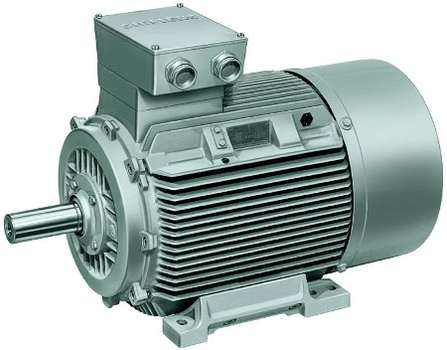
Electric rewind motors
Typically, rewinding an old electric motor is much cheaper than buying a new one.
The electric motor should be replaced if the cost of rewinding it is more than 60% of the cost of a new one.
Then it will all depend on how the rewinding is done.
If the work is done at the highest level, the engine will lose only 1% to 2% percent of its efficiency.
If the rewinding is performed incorrectly, the losses in the electric motor will increase by 5% -10%.
Replacing the old electric motor with a new, fuel-efficient motor makes sense in cases where the motor is running more than 2, 000 hours per year.
The payback period of a new fuel-efficient engine will not exceed 1. 5-2 years.
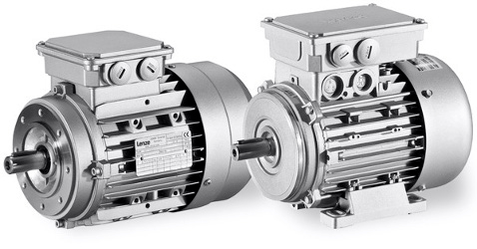
Energy saving in the company by increasing the load factor
The load factor is the ratio of operating power to apparent power.
This is how energy is used efficiently.
The higher the load factor, the more efficiently the electricity is used.
The electric motor operates optimally at 75% load and above.
Therefore, installing motors above the required power (for safety reasons) will not only be more expensive, but also inefficient in terms of power consumption.
The load factor can be increased as follows:
- stopping unloaded engines,
- replacement of engines, which are loaded at less than 45%, for less powerful models,
- redistribution of load between existing electric motors.
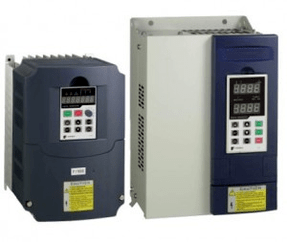
Variable Frequency Drive (VFD)
Installing frequency converters only makes sense for dynamic systems.
In static systems, which are involved, for example, only for lifting loads, installing a frequency converter will not help and can often hurt.
The VFD balances the load and speed of the motor, ensuring that electrical energy is used optimally.
The VFD can reduce the power consumption of the motor by a minimum of 5% and a maximum of 60%.
The payback period for VFD is usually 1 to 3 years.
Optimization of compressed air systems
Compressed air is used in a wide variety of industries.
In some companies, compressed air is the main consumer of electricity.
Compressed air is used in pneumatic devices and equipment, on conveyors, automatic lines.
The use of compressed air is popular because it is a convenient and safe source of energy.
But many people forget that compressed air is one of the most inefficient energy sources - only 5% of the electricity spent on compressed air production turns into useful work, the remaining 95% goes tothe pipe.
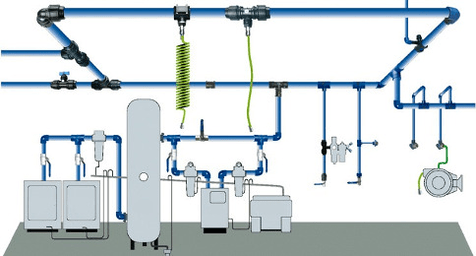
Energy saving in the company - compressed air:
- Do not use compressed air to clean the premises.
- Reducing the air temperature at the compressor inlet by 3% reduces power consumption by 1%.
- For these technical processes, if possible, reduce the compressed air pressure to a minimum. Lowering the pressure by 10% reduces power consumption by 5%.
- Perform regular inspections, repairs of compressor equipment and compressed air transmission lines. Even the smallest compressed air leak can sometimes reduce equipment efficiency.

Energy saving in the company - we reduce heat and steam losses
Steam is often used in industry, especially in the textile, food and processing industries.
Improving the efficiency of steam boilers and reusing the heat generated can significantly reduce the energy consumption of these installations.
Steam production
The boiler operates more efficiently at full power.
Due to the fact that the demand for the amount of steam can change over time, it often happens that the boiler operates below its optimum load.
The installed boiler capacity can be much greater than the needs of the business, due to a drop in demand for products or unfulfilled plans to expand production.
In addition, the capacity of the boiler may not be required due to improvements in the production process or the introduction of energy saving measures.
In such cases the boiler will either operate not at full capacity or in short on-off cycle mode.
These two situations lead to significant energy losses.
There are no cheap and easy solutions to this problem.
The simplest option isinstall a "small" boiler that will operate at full capacityat an average or low workload in the company.
While not a cheap solution, the payback period for such an investment can be less than two years.
And, in general, it is always more efficient to have several interchangeable small boilers, especially in businesses with changing demand or large seasonal fluctuations in heat and steam consumption.
Automatic regulation system
If the company has several boilers, it makes sense to installautomatic boiler load regulation system. . .
Automation addresses the need for steam in the business, redistributing the load between boilers, turning the boilers on or off, dramatically increasing the efficiency of the entire system.
Gate valve
In businesses where boilers are regularly shut down due to a drop in steam demand, the heat loss through the chimney can be quite high.
It is possible to block the loss of hot air through the chimneyby installing a gate valvewhich closes the pipe when the boiler is off.
Prevention and maintenance
If left unattended, burners and condensate return systems can quickly deteriorate or fail.
This can reduce the efficiency of the boiler by 20-30%.
A simple maintenance program - ensuring that all boiler components are operating at their maximum level - will greatly increase operating efficiency.
In practice, regular maintenance reduces the energy consumption of the boiler by 10%.
Insulation - the heat loss from the surface of a properly insulated boiler should be less than 1%.
Removal of soot and scale
It is necessary to constantly monitor and remove the formation of soot on the boiler tubes, scale inside the boiler.
A 0. 8 millimeter thick layer of soot reduces heat transfer by 9. 5%, while a 4. 5 millimeter thick layer reduces heat transfer by 69%!
Scale is formed when calcium, magnesia and silicon are deposited on the heat exchanger of the boiler.
The 1-millimeter-thick scale increases energy consumption by 2%.
Soot and scale can be removed mechanically or with acids.
The formation of soot and scale can be determined by an increase in the flue gas temperature or by a visual inspection when the boiler is not in operation.
The formation of soot and scale must be monitored especially if the boiler is operated with solid fuels (coal, peat, firewood).
Gas boilers are less prone to soot problems.
Boiler purge optimization
Boiler purge is the removal of water from the boiler to clean the water inside the boiler from impurities and salts.
The purpose of venting the boiler is to prevent or reduce the build-up of scale.
Insufficient venting of the boiler can cause water to enter the steam or build up deposits in the boiler.
Excessive purging means loss of heat, water and chemicals.
The optimum purge level depends on the type of boiler, the operating pressure in the boiler, the preparation and the quality of the water used.
The first thing to pay attention to is preparing the water. If the water is well treated (low in salt), the purge rate can be 4%.
If there are foreign substances and salts in the water, the purge rate will be 8% to 10%.
The automatic purge system can also greatly reduce power consumption.
The payback period for such a system is usually 1 to 3 years.
Reduction of smoke emissions
Too much smoke is often the result of air entering the boiler and chimney through leaks and openings.
This reduces heat transfer and increases the load on the compressor system.
Leaks and holes can be easily removed, it is sufficient to periodically perform a visual inspection of the boiler and chimney.
Air regulation
The more air you use to burn fuel, the more heat is projected into the wind.
A quantity of air slightly greater than the ideal stoichiometric fuel / air ratio is required for safety reasons, to reduce NOx emissions, and depends on the type of fuel.
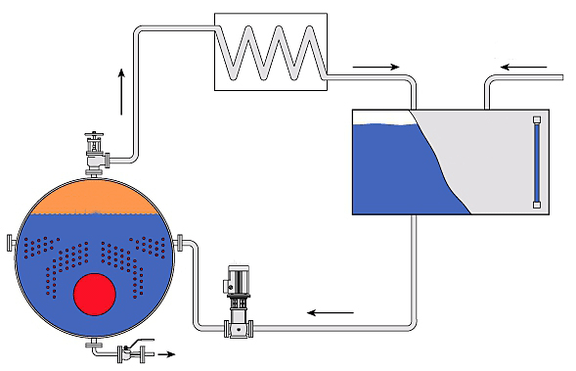
Boilers in poor technical condition can use up to 140% more air, resulting in excessive smoke emissions.
An efficient gas burner requires 2-3% more oxygen or 10-15% more air to burn fuel without generating carbon monoxide.
The general rule of thumb is that the efficiency of the boiler increases by 1% for every 15% reduction in additional air.
Therefore, it is necessary to constantly check the fuel / air ratio.
This event does not cost anything, but it has a very good effect.
Smoke emission monitoring
The amount of oxygen in the flue gases is the sum of the extra air (added to increase safety and reduce emissions) and the air that enters the boiler through holes and leaks.
The presence of leaks and holes can be easily detected if a system for monitoring the incoming air and the amount of oxygen in the flue gases is in place.
By using the data on the amount of carbon monoxide and oxygen, it is possible to optimize the fuel / air ratio in the boiler.
The installation of a system for monitoring and analyzing smoke emissions generally pays for itself in less than a year.
Energy saving in the company - Installation of an economiser
The heat from the flue gases can be used to heat the water entering the boiler.
The heated water enters the boiler and requires less heat to be converted into steam, thus saving fuel.
The boiler efficiency increases by 1% for each 22 ° C drop in the flue gas temperature.
The economizer can reduce fuel consumption by 5-10% and will pay off in less than 2 years.
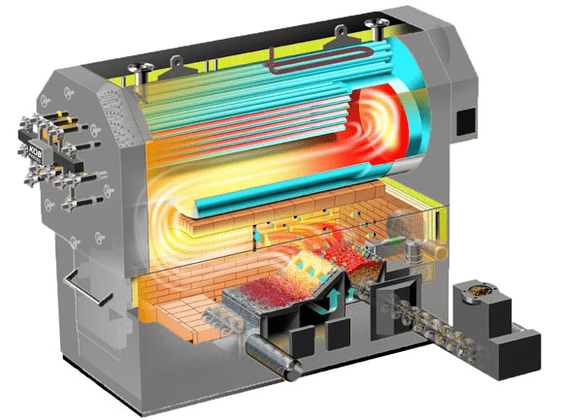
Heat exchanger to extract heat from water and steam when purging the boiler
The heat exchanger will help recycle about 80% of the heat from the water and steam from the boiler blowdown.
This heat can be used to heat buildings or to heat the water that feeds the boiler.
Any boiler with a constant purge rate of 5% or more is an excellent candidate for a heat exchanger.
If the purge system does not work in constant mode, then it makes sense to think about transferring it to constant mode while simultaneously installing a heat exchanger.
The average payback period of a heat exchanger will not exceed 1. 5-2 years.

Installation of a condensing economizer
Hot condensate can be returned to the boiler, saving energy and reducing the need for treated water.
The condensing economizer can increase the efficiency of the system by an additional 10%.
Installation of such an economizer should be carried out under the close supervision of specialists who will take into account all the nuances of such a system, its effect on the boiler and the chemical composition of the water.
Using a system that returns condensate to the boiler usually pays for itself in 1 to 1. 5 years.
A system that directs condensate to a hot water supply pays for itself in less than a year.
<10_img_centerxx>Cooling towers (cooling towers)
A cooling tower is a heat exchanger in which water is cooled by a stream of air.
And in terms of energy efficiency, a cooling tower is a device that releases heat into the wind.
Potential for energy savings in cooling towers:
- In some companies, it makes sense to abandon cooling towers altogether. There are many cases where the heater is used to heat a room and at the same time a cooling tower is used to dissipate the heat. Installing a heat pump will solve the heating problem and at least partially reduce the need to use the cooling tower.
- Installing circuit breakers for cooling tower fans can reduce energy consumption by 40%.
- Replacing aluminum or iron fans with new fans (fiberglass and molded plastic) can reduce energy consumption by up to 30%.

Reduction of losses in steam lines
Disconnection of unclaimed steam lines
Steam needs and consumption are constantly changing.
This can lead to the fact that the entire steam distribution system is not used at full capacity, but only at 20% -50%, which inevitably leads to heat loss.
It is clear that optimizing or reconfiguring the entire steam delivery system to meet the new needs will be very expensive and, perhaps, impossible.
However, identifying and shutting down infrequently used steam lines can be a very effective energy saving measure.
Energy saving in the company - Thermal insulation of pipes
Insulating steam lines can reduce energy loss by up to 90%.
This is one of the fastest returns on energy savings in a steam distribution system.
The average payback period for insulating pipelines through which steam or hot water is transmitted is approximately 1 year.
Condensate pipes for 1. 5-2 years.
Monitoring of steam traps
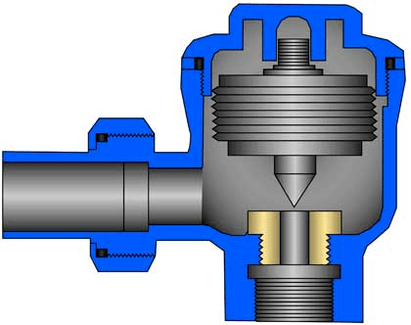
A simple program of monitoring the technical condition of steam traps can significantly reduce heat loss.
For example, if maintenance has not been performed for 3-5 years, then typically about a third of steam traps have failed, allowing steam to seep into the exhaust system. condensates.
In practice, in companies that have a trap monitoring program, no more than 5% of the traps are in poor condition.
The average payback period for replacing or maintaining a trap is less than six months.
A steam trap monitoring program will generally reduce steam loss by 10%.
Thermostatic steam traps
The use of modern thermostatic traps can reduce energy consumption while increasing the reliability of the entire system.
The main advantage of thermostatic traps is that they
- open when the temperature approaches the saturated steam level (+/- 2 C °),
- emit non-condensable gases after each opening and
- are in the open state at the start of system operation, which ensures its rapid heating.
In addition, these steam traps are very reliable and can be used over a wide range of pressures.
Disconnecting steam traps
You can reduce energy consumption by shutting off steam traps on superheated steam lines when not in use.
Elimination of steam leaks
A small steam leak repair program can pay off in less than 3 to 4 months.
It should be remembered that small leaks can go unnoticed for years, constantly damaging the system.
Reuse of condensate and steam
When a trap removes condensate from a steam system, the pressure drop creates steam from that condensate.
This steam, along with the condensate, can be used in a heat exchanger to heat feed water or air.
More importantly, it is possible to use this steam and condensate near the point of discharge, as it can be very expensive to create a separate piping system to transport it to the point of use.
























